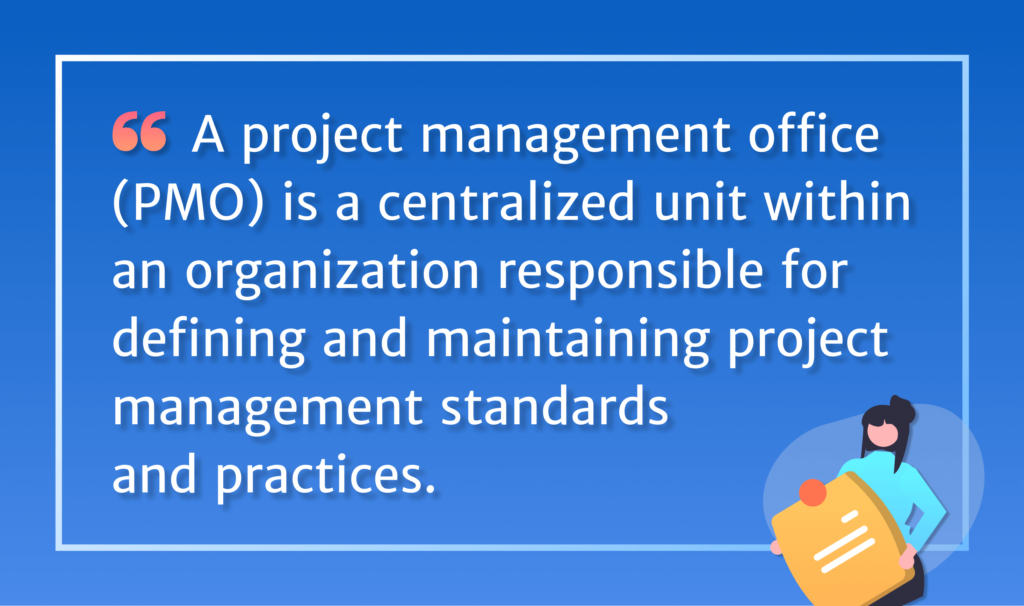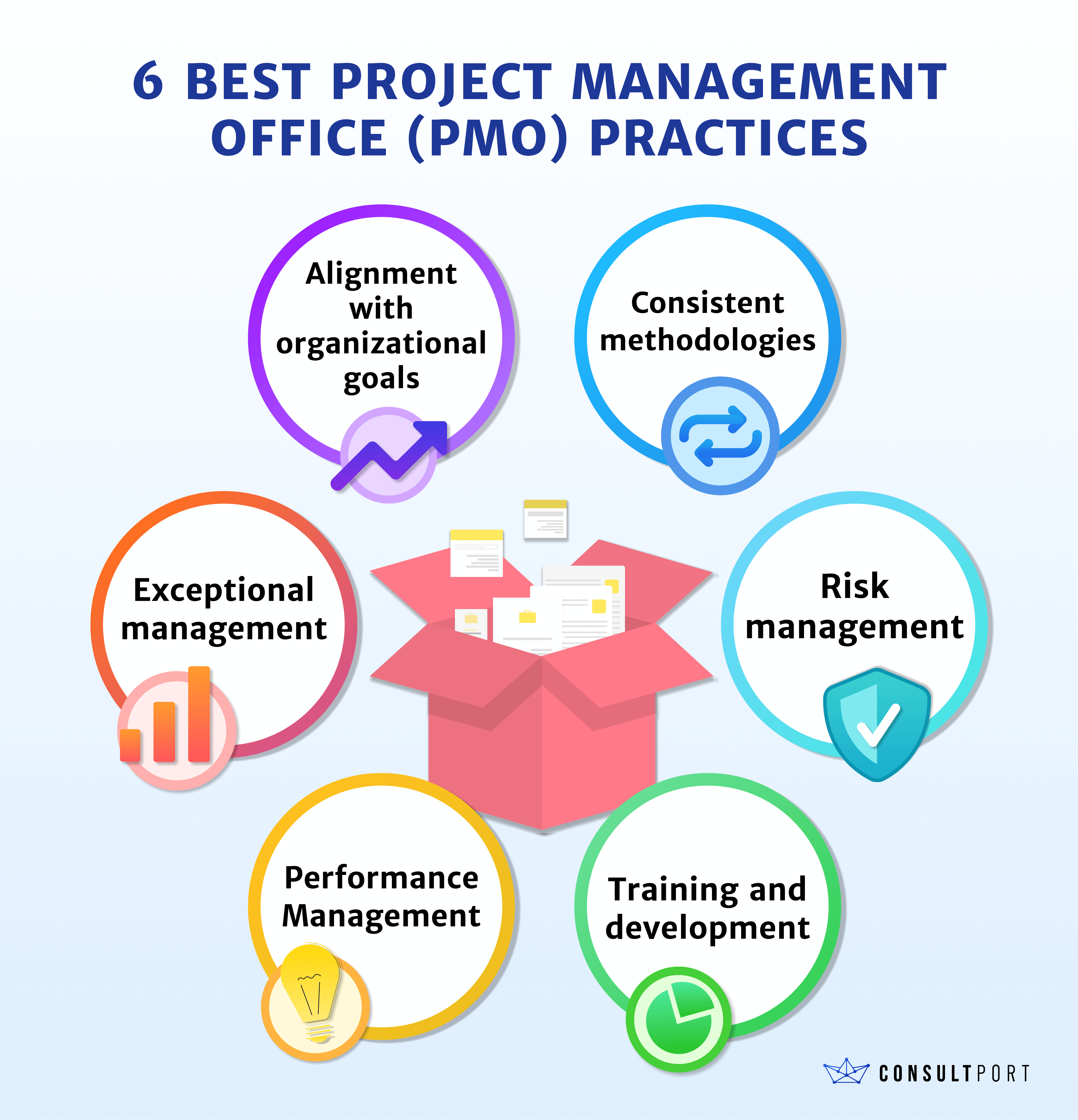6 Essential PMO Best Practices


Share this article

Ever wondered how some organizations seem to effortlessly manage a multitude of projects, and ensure they align seamlessly with their strategic goals?
Well, if you're curious about the players behind the curtain, you've come to the right place! In this article, we're going to embark on a fascinating voyage into the realm of Project Management Offices, commonly known as PMOs.
First, we’ll start with what they are and why they matter so much. We'll then explore the six best practices that are at the core of PMO success. Whether you’re an experienced project management consultant or a newbie who’s still deciding what to specialize in, this article is for you.
So, let’s dive into it.
Well, if you're curious about the players behind the curtain, you've come to the right place! In this article, we're going to embark on a fascinating voyage into the realm of Project Management Offices, commonly known as PMOs.
First, we’ll start with what they are and why they matter so much. We'll then explore the six best practices that are at the core of PMO success. Whether you’re an experienced project management consultant or a newbie who’s still deciding what to specialize in, this article is for you.
So, let’s dive into it.
KEY TAKEAWAYS
- A Project Management Office (PMO) is a centralized unit in an organization that is responsible for defining and maintaining project management standards and practices.
- The PMO plays a critical role in ensuring that projects align with the organization's strategic objectives and are executed efficiently. It also deals with aspects like resource allocation, progress tracking, and risk management.
- Clear roles and responsibilities are established by the PMO to streamline decision-making and issue resolution.
- PMOs proactively identify, assess, and mitigate project risks through a risk management framework.
- Online consulting platforms like Consultport can help experienced PMO consultants find high-paying and flexible freelance projects with top clients.
What Is a Project Management Office (PMO)?
A project management office (PMO) is a centralized unit within an organization responsible for defining and maintaining project management standards and practices. Consider it the central hub for all the projects. A project management office plays a critical role in ensuring that projects and programs are executed efficiently and align with the organization's strategic objectives.

Besides this, a PMO sets up standardized methods and processes that make project management super efficient and consistent across the board. It also deals with things like rules, resource allocation, keeping tabs on progress, and handling risks. Now, let’s consider an example to make this clearer.
For instance, a large IT company might establish a PMO to oversee its software development projects. The PMO would define project management standards and processes to ensure that all software development initiatives follow the same procedures. It would also prioritize projects based on the company's strategic goals, allocate resources like software developers and budgets to each project, and closely monitor progress and risks. Thus, the PMO ensures that the company delivers top-notch software products on time and within budget.

Besides this, a PMO sets up standardized methods and processes that make project management super efficient and consistent across the board. It also deals with things like rules, resource allocation, keeping tabs on progress, and handling risks. Now, let’s consider an example to make this clearer.
For instance, a large IT company might establish a PMO to oversee its software development projects. The PMO would define project management standards and processes to ensure that all software development initiatives follow the same procedures. It would also prioritize projects based on the company's strategic goals, allocate resources like software developers and budgets to each project, and closely monitor progress and risks. Thus, the PMO ensures that the company delivers top-notch software products on time and within budget.
6 Project Management Office (PMO) Best Practices
Now that you know what a PMO is, let’s dig a little deeper. You see, implementing PMO best practices is crucial for ensuring that a project management office functions effectively. In addition, using best practices ensures great results, big paychecks, happy clients, and new exciting projects. So, let’s discuss the six best practices for PMOs.

For example, a manufacturing company's PMO ensures that all projects, from product development to supply chain optimization, align with the company's strategic goal: reduction of production costs. This alignment helps the organization achieve its overarching objective of increasing profitability.
Let’s take an IT company's PMO as an example. Suppose it enforces a standardized Agile project management methodology across all software development projects. This uniform approach allows for easy knowledge transfer between project teams and ensures that Agile principles, such as regular iterations and customer feedback, are consistently applied.
For example, in a government agency, the PMO defines a management structure for a large infrastructure project. It clearly outlines the roles and responsibilities of the project manager, the steering committee, and the regulatory authorities. This structure streamlines decision-making and ensures a clear chain of command.
For example, in a software development project, the PMO identifies potential risks like software bugs, resource shortages, and scope changes. For this reason, they create a risk register, assess the impact and likelihood of these risks, and develop action plans to mitigate them. For instance, they establish a contingency plan for addressing unexpected scope changes, which ensures that the project remains on track.
For example, a healthcare organization's PMO implements a performance dashboard that tracks key metrics in a patient data system upgrade project. This dashboard enables project managers and executives to monitor progress, identify delays, and make data-driven decisions to keep the project on schedule and within budget.

For example, a tech company's PMO offers project management workshops and online courses to its team. So, a junior project manager takes a PMP certification course to enhance their skills. This investment in training boosts individual competencies and elevates the organization's overall project management expertise. Ultimately, this results in more successful project outcomes and improved efficiency.

1. Alignment with organizational goals
First things first, the PMO makes sure that projects don't go rogue. Therefore, the PMO should align various activities and project portfolio with the strategic objectives of the organization. It's essential that the projects the PMO supports contribute to the overall mission and vision of the company.For example, a manufacturing company's PMO ensures that all projects, from product development to supply chain optimization, align with the company's strategic goal: reduction of production costs. This alignment helps the organization achieve its overarching objective of increasing profitability.
2. Consistent methodologies
You know what? The PMO doesn't leave anything to chance. They've got these super-smooth, standardized project management methods that keep everyone on the same page. It's like a well-orchestrated dance, making it easy to track progress, share resources, and spread knowledge. So, no project chaos is allowed!Let’s take an IT company's PMO as an example. Suppose it enforces a standardized Agile project management methodology across all software development projects. This uniform approach allows for easy knowledge transfer between project teams and ensures that Agile principles, such as regular iterations and customer feedback, are consistently applied.
3. Exceptional management
It's all about setting up the rules of the game. That’s why the PMO lays down the law with clear roles and responsibilities. In precise terms, it sets clear project governance structures, roles, and responsibilities. This helps ensure that decision-making is efficient and that there's a clear chain of command for resolving issues and risks.For example, in a government agency, the PMO defines a management structure for a large infrastructure project. It clearly outlines the roles and responsibilities of the project manager, the steering committee, and the regulatory authorities. This structure streamlines decision-making and ensures a clear chain of command.
4. Risk Management
The PMO is like a psychic for project issues. They see the future (or at least they try to) by identifying, assessing, and mitigating project risks before they turn into giant problems. The fact is that being proactive in managing risks can prevent project disruptions and delays. That’s the reason why the PMO establishes a risk management framework to identify, assess, and mitigate project risks.For example, in a software development project, the PMO identifies potential risks like software bugs, resource shortages, and scope changes. For this reason, they create a risk register, assess the impact and likelihood of these risks, and develop action plans to mitigate them. For instance, they establish a contingency plan for addressing unexpected scope changes, which ensures that the project remains on track.
5. Performance management
Ever had a project tracker that keeps you accountable? That's the PMO for you. They set up robust systems to track projects so that everyone can see how the team is doing. The PMO can implement powerful project tracking and reporting mechanisms. This enables stakeholders to monitor project progress, identify issues early, and make data-driven decisions.For example, a healthcare organization's PMO implements a performance dashboard that tracks key metrics in a patient data system upgrade project. This dashboard enables project managers and executives to monitor progress, identify delays, and make data-driven decisions to keep the project on schedule and within budget.
6. Training and development
If you’ve ever seen a sports coach, you must have noticed how they push the team forward. The PMO is like that for project managers and teams. They offer training and support to level up your project management skills. You see, learning is an ongoing process, no matter how qualified someone is. That’s why investing in the development of project management skills and competencies ensures that projects are executed with a high degree of professionalism.
For example, a tech company's PMO offers project management workshops and online courses to its team. So, a junior project manager takes a PMP certification course to enhance their skills. This investment in training boosts individual competencies and elevates the organization's overall project management expertise. Ultimately, this results in more successful project outcomes and improved efficiency.
How Project Management Office (PMO) Consultants Can Help
In today's complex business world, organizations often grapple with a lack of transparency, inefficiencies, and missed opportunities. These pain points can lead to project delays, cost overruns, and an overall lack of alignment with long-term strategic goals. This is where a Project Management Office (PMO) consultant from Consultport becomes the solution.
They'll swoop in and establish streamlined governance, bring in standardized methodologies, and provide a structured framework that clears up all the confusion. No more "who's responsible for what" questions—it's all crystal clear. In addition to this, they can be your expert connectors and ensure everyone's on the same page by identifying and fixing risks before they become big problems. We have over 10,000 experts in our talent pool, all of whom have worked for top-tier consulting firms or blue-chip companies. If you’re an experienced consultant who has worked with the best consulting firms, we can help you find freelance projects. So, feel free to go through our website, and get in touch if you meet the requirements. You could be a freelance PMO consultant soon and choose your own projects, hours, and location—sounds like a win-win.

They'll swoop in and establish streamlined governance, bring in standardized methodologies, and provide a structured framework that clears up all the confusion. No more "who's responsible for what" questions—it's all crystal clear. In addition to this, they can be your expert connectors and ensure everyone's on the same page by identifying and fixing risks before they become big problems. We have over 10,000 experts in our talent pool, all of whom have worked for top-tier consulting firms or blue-chip companies. If you’re an experienced consultant who has worked with the best consulting firms, we can help you find freelance projects. So, feel free to go through our website, and get in touch if you meet the requirements. You could be a freelance PMO consultant soon and choose your own projects, hours, and location—sounds like a win-win.

Share this article
Premium content,
on a weekly basis.
on a weekly basis.
Subscription implies consent to our privacy policy.
×
Subscribe to our newsletters!
Discover our Consultant's Expertise
Ready to get access to the world’s best consultants?
